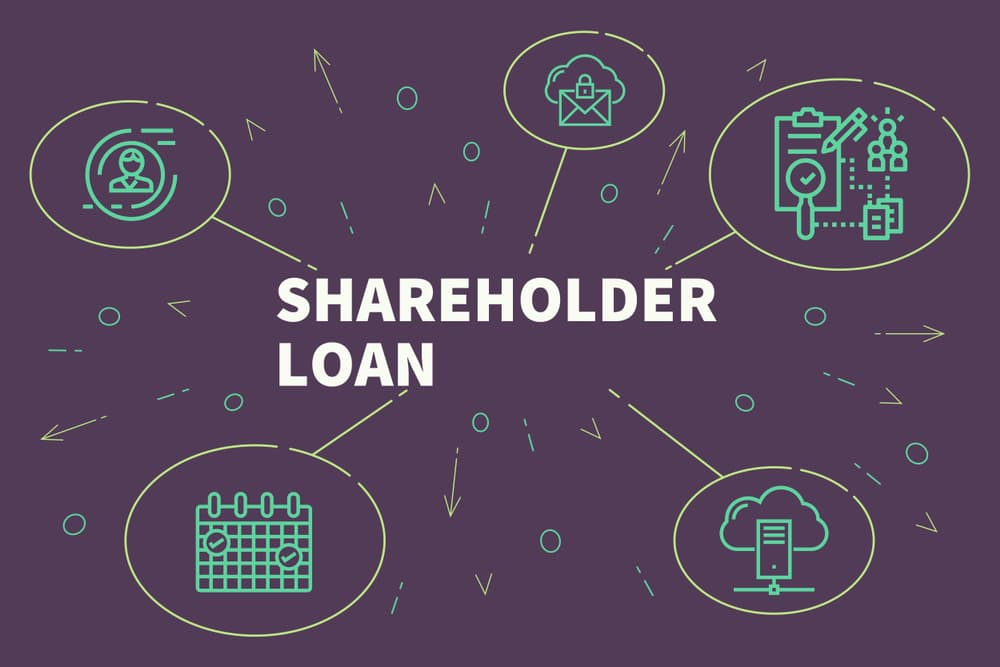As an owner of a business, you should always look for ways to manage cash flow in the most tax-efficient manner. One of the financial aspects of business ownership many owner-managers overlook is understanding the tax implications of borrowing from or lending money to the business. With proper knowledge, you will have better control over the finances ensuring everything works together to grow your wealth. It allows you to minimize your tax bill within the confines of the law, so you have more money to reinvest or use as you see fit.
Shareholders of incorporated businesses have access to a vital tool for managing cash flow through shareholder loans. This is an agreement to borrow money from your own corporation, acting as a short-term loan, or it can be converted to a form of remuneration, much like dividends or your salary. Funds are temporarily withdrawn from the corporation at low interest, which is an opportunity that also comes with tax implications. Shareholder loans can also go the other way, where an owner lends money to the corporation.
Here we look at the shareholder loan, how to use it for tax planning and other purposes, and whether it is the right choice for you.

What is a Shareholder Loan?
Generally speaking, a shareholder loan balance refers to money you have provided to the corporation or money you’ve taken out of the business. These loans are specified as either “due from shareholder” or “due to shareholder,” depending on the specifics. In other words, you can either lend money to your company or borrow from it with a shareholder loan. These activities are being tracked via the shareholder loan account.
What are the Tax Benefits of Shareholder Loans?
When handled correctly, you can access funds for almost two years, tax-free at a low-interest rate. If you don’t pay the loan back within the year, you can take advantage of reporting the loan on your income in the following year if you’re in a lower tax bracket, thus achieving tax deferral and reducing your overall tax bill. In contrast, if the shareholder loan has a “credit” balance or is being reflected as a liability on your company’s balance sheet, you can withdraw any excess cash in your company’s bank account against the cumulative shareholder loan balance completely tax-free. This tax planning tool should be considered before paying yourself a salary or dividends to reduce your overall personal income tax bill.
How Does Shareholder Loan Differ from Salary & Dividends for Personal Taxes?
A shareholder loan represents a loan that is not considered income by the CRA if it is paid back within the end of the next fiscal year.
Dividends from a corporation to a shareholder are funded by corporate profits after taxes, which you must include as shareholder’s personal income on your personal tax return in the year you receive the funds.
Salary is also considered as personal employment income upon receipt. However, it is subject to CRA-administered payroll compliance requirements. Each paycheque requires calculation and payment of CRA payroll deductions, including CPP, EI, and income tax. The deductions generally need to be remitted by the 15th of the month following your salary payment. From a cash flow standpoint, shareholder loans could provide more funds from the outset as the interest for the loan is lower than the taxes and deductions paid out for dividends and salaries.
Common Shareholder Loan Scenarios
Here are some common ways a shareholder loan is used to give you an idea of what it looks like in real life.
Owner Withdrawal – A business owner withdrawing company money is the most common example of how a shareholder loan can be used. If company funds are withdrawn and not labelled as salary or a dividend by accounting, it is considered a corporate loan to the shareholder. This is a classic example of a “due from shareholder” loan. It is reflected as an asset item with a “debit” balance on the company balance sheet.
Using Company Funds to for Personal Expense – Another “due from shareholder” loan is if a shareholder purchases a personal related item using funds from the company. This type of non-business purchase can include just about anything under the sun. But if the shareholder does not pay back the money, she must include that total on her personal income tax for the year.
Owner Contribution – Sometimes, a shareholder will deposit a portion of his own money into the business to cover operational expenses. This is defined as an owner contribution, which creates a shareholder loan account. The shareholder has loaned funds to the company, and the business must repay the shareholder back at some point. This is an example of a “due to shareholder” transaction. It’s not uncommon to see “due to shareholder” balances when a company is still young, as the owner often funds the company until it can pay its expenses. It Is reflected as a liability item with a “credit” balance on the company balance sheet.
Paying for Company Expenses with Personal Funds – If a shareholder pays for company expenses with his personal money (e.g. personal credit card), it will be recognized as a “due to shareholder” transaction in the shareholder loan account. An example of this may be a business owner using his personal credit card to take a prospective client out for meal and drinks, and as a result the company owes the shareholder for the amount spent.
What a Shareholder Loan Balance Represents
A balance in the shareholder loan account represents is the cumulative total of all shareholder loan related transactions that are going on at any one given time. This is being tracked through the shareholder loan account. You can have both a shareholder loan debit balance and a shareholder loan credit balance. The debit balance is the amount of money you withdraw from the company (due from shareholder), and it will continue to increase as you continue to withdraw money and decrease as you make payments against the loan. The reverse is true with a shareholder credit balance, showing a running total of what the company owes the shareholder (due to shareholder).

How to Avoid Potential Shareholder Loan Tax Problems
Since the shareholder loan can be abused, you can find yourself faced with unexpected tax challenges. If you have a “due from shareholder” balance and do not pay back your shareholder loan for more than a year, it starts to look a lot more like taxable income than a shareholder loan to the CRA. If this happens, your company can’t deduct the loan like a salary, and you would also need to pay tax personally tax on the loan. This creates an issue of double taxation, which you certainly want to avoid. Although you can get a personal tax deduction once you repay the loan, it may not be the most tax efficient scenario.
Here are a few scenarios that will help ensure the CRA looks at your loan favourably and avoid surprise tax bill:
Avoid a Series of Loans and Repayments
According to the Income Tax Act, shareholder loans cannot create a pattern of repayments made as part of a series of loans. Bona fide arrangements should be designed to ensure repayment is scheduled at the time the loan is made or when the borrower’s indebtedness occurred. The CRA looks for a series of loans where several loans are made, with one loan and one repayment transaction happening in each taxation year.
Often when the repayment is made just before the year’s end, and the same amount is borrowed shortly after the repayment, this creates a series of loans. The CRA would view the original shareholder loan as not repaid on time. Thus the loan is included as taxable income on the personal tax return without a corresponding tax write-off for the company resulting in double taxation. The only way to avoid this scenario is to repay the loan by converting it into a salary or dividends. In this case, the CRA will not consider the repayment part of a series of loans.
Timely Repayment
The best way to avoid a shareholder loan issue is to ensure you repay the principal balance via the shareholder loan account in a timely manner. When you pay back the loan before the end of the following fiscal year, you can consider a loan later next year to prevent the risk of double taxation if it is not a series of loans and repayments.
Create a Bona Fide Agreement
Drawing up a bona fide written agreement with the details of the loan is another way to prove to the CRA that the funds were a loan, not a taxable income. The agreement should include the following:
- A payment schedule
- Interest rate
- The loan amount with interest
- Default details
Withdrawing Funds as Salary or Dividends
You can also avoid a shareholder loan issue altogether and instead take one of the following steps. However, you should be aware of the tax implications between salary vs dividends.
- Paying a salary: As a shareholder working in the capacity of an employee, you can also earn a salary. By declaring withdrawals as employment income from your salary, you avoid double taxation. Although you still have to pay personal tax on the income, the salary is tax deductible for the company. With your own tax payment, you receive less than you would from a loan, even considering the interest. Still, it does avoid common tax issues related to an improper shareholder loan CRA auditors must address.
- Paying dividends: Dividends are also declared on personal income taxes, but the funds go directly into your account. Also, on the personal tax side, you generally have a lower tax rate than you would for your salary, thanks to the dividend tax credit mechanism. You avoid double taxation, get more of the dividend in your own pocket than a salary and avoid the administrative burden of complying with payroll regulations.
On the positive side, shareholder loans allow the owner withdrawing money without worrying about a tax liability as long as you pay it back within the following fiscal year. On the downside, you can face double taxation issues. Double taxation commonly occurs when you fail to repay your loan on time or when the CRA believes you have received a series of loans, thus creating a pattern of missed repayments and ongoing loans for the benefit of tax deferrals.
Common Shareholder Loan FAQs
Below are some frequently asked questions about shareholder loans that will point you in the right direction and help give you the necessary information.
Q: When does a “due from shareholder” loan have to be repaid?
A: A shareholder loan must be repaid to the business by the end of the next fiscal year after the issuance of the loan. For example, if an owner borrows $10,000 as a shareholder loan in October of 2023 and the business’s fiscal year end is November 30, then it should be paid back by November 30, 2024, which is the next fiscal year-end.
Q: What happens if the shareholder loan is not paid back on time?
A: If you don’t repay a shareholder loan before the end of the next fiscal year, it may result in that amount being counted towards your personal income for the year the loan was created.
Q: Can I pay back the loan before the end of the next fiscal year, then make another withdrawal on the first day of the following year?
A: The CRA is aware of this sort of tactic, and there are specific tax rules in place to help prevent it from happening. Any repayment can’t be in the form of a series of loans and repayments.
Q: How do I repay my shareholder loan?
A: The easiest way to pay back a shareholder loan is to transfer the money from your personal account to the corporate account. Writing a cheque is also a viable option, but the method is not overly critical as long as the funds are sent back to the business.
Q: Is shareholder advance the same as shareholder loan?
A: Shareholder advance is a term that represents the funds being loaned to the company by a shareholder. It is interchangeable with a shareholder loan or “due to shareholder” with a credit balance. This can also be created if you pay company expenses with your personal credit card. It is shown on a balance sheet as a liability because the company owes the shareholder money.
Q: How is shareholder loan being presented on the balance sheet?
A: The shareholder loan balance is a balance sheet account displayed as either a liability or an asset. Depending on the repayment terms, it could be reflected as a current account or a long-term account. The current liability account is for a loan due within the next 12 months, and the long-term liability account is for a loan due beyond 12 months.
Q: What is the purpose of a shareholder loan?
A: A shareholder loan can be used for many purposes. It can be used to track funds borrowed from the company. This often occurs when the shareholder needs cash to make a purchase over some type of personal expense. It can also be used to monitor the shareholder’s contributions as a due to shareholder balance, which can be distributed back to the shareholder tax-free.
Q: Should I consider a shareholder loan as a debt?
A: Yes, a shareholder loan is typically considered a liability or debt for whoever borrows the money. If the shareholder borrows money, it is the shareholder’s personal debt. And if the business borrows funds from the shareholder, it is the company’s debt.
We Are Here to Help
Discussing your company’s shareholder loan with a qualified accountant can help you avoid penalties the CRA applies for unintentional tax issues. At WTC Professional Chartered Accountant, our corporate tax accountant can help with tax planning strategies and decide whether shareholder loans are a tactic to consider. Reach out to our team today.
